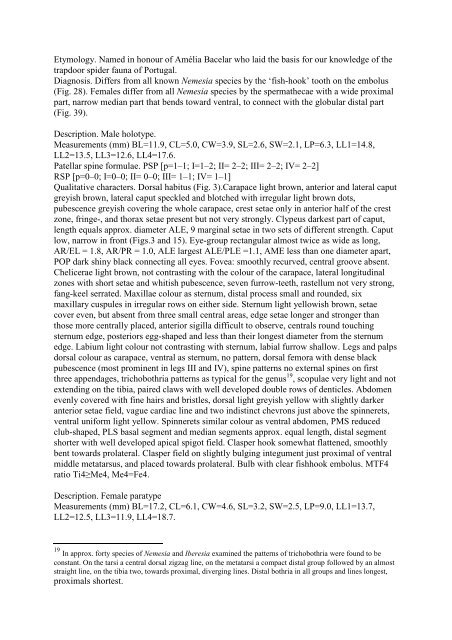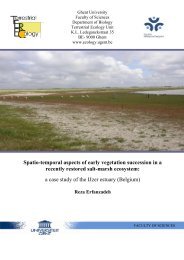PhD Arthur Decae 2010 - Ghent Ecology - Universiteit Gent
PhD Arthur Decae 2010 - Ghent Ecology - Universiteit Gent
PhD Arthur Decae 2010 - Ghent Ecology - Universiteit Gent
You also want an ePaper? Increase the reach of your titles
YUMPU automatically turns print PDFs into web optimized ePapers that Google loves.
Etymology. Named in honour of Amélia Bacelar who laid the basis for our knowledge of the<br />
trapdoor spider fauna of Portugal.<br />
Diagnosis. Differs from all known Nemesia species by the ‘fish-hook’ tooth on the embolus<br />
(Fig. 28). Females differ from all Nemesia species by the spermathecae with a wide proximal<br />
part, narrow median part that bends toward ventral, to connect with the globular distal part<br />
(Fig. 39).<br />
Description. Male holotype.<br />
Measurements (mm) BL=11.9, CL=5.0, CW=3.9, SL=2.6, SW=2.1, LP=6.3, LL1=14.8,<br />
LL2=13.5, LL3=12.6, LL4=17.6.<br />
Patellar spine formulae. PSP [p=1–1; I=1–2; II= 2–2; III= 2–2; IV= 2–2]<br />
RSP [p=0–0; I=0–0; II= 0–0; III= 1–1; IV= 1–1]<br />
Qualitative characters. Dorsal habitus (Fig. 3).Carapace light brown, anterior and lateral caput<br />
greyish brown, lateral caput speckled and blotched with irregular light brown dots,<br />
pubescence greyish covering the whole carapace, crest setae only in anterior half of the crest<br />
zone, fringe-, and thorax setae present but not very strongly. Clypeus darkest part of caput,<br />
length equals approx. diameter ALE, 9 marginal setae in two sets of different strength. Caput<br />
low, narrow in front (Figs.3 and 15). Eye-group rectangular almost twice as wide as long,<br />
AR/EL = 1.8, AR/PR = 1.0, ALE largest ALE/PLE =1.1, AME less than one diameter apart,<br />
POP dark shiny black connecting all eyes. Fovea: smoothly recurved, central groove absent.<br />
Chelicerae light brown, not contrasting with the colour of the carapace, lateral longitudinal<br />
zones with short setae and whitish pubescence, seven furrow-teeth, rastellum not very strong,<br />
fang-keel serrated. Maxillae colour as sternum, distal process small and rounded, six<br />
maxillary cuspules in irregular rows on either side. Sternum light yellowish brown, setae<br />
cover even, but absent from three small central areas, edge setae longer and stronger than<br />
those more centrally placed, anterior sigilla difficult to observe, centrals round touching<br />
sternum edge, posteriors egg-shaped and less than their longest diameter from the sternum<br />
edge. Labium light colour not contrasting with sternum, labial furrow shallow. Legs and palps<br />
dorsal colour as carapace, ventral as sternum, no pattern, dorsal femora with dense black<br />
pubescence (most prominent in legs III and IV), spine patterns no external spines on first<br />
three appendages, trichobothria patterns as typical for the genus 19 , scopulae very light and not<br />
extending on the tibia, paired claws with well developed double rows of denticles. Abdomen<br />
evenly covered with fine hairs and bristles, dorsal light greyish yellow with slightly darker<br />
anterior setae field, vague cardiac line and two indistinct chevrons just above the spinnerets,<br />
ventral uniform light yellow. Spinnerets similar colour as ventral abdomen, PMS reduced<br />
club-shaped, PLS basal segment and median segments approx. equal length, distal segment<br />
shorter with well developed apical spigot field. Clasper hook somewhat flattened, smoothly<br />
bent towards prolateral. Clasper field on slightly bulging integument just proximal of ventral<br />
middle metatarsus, and placed towards prolateral. Bulb with clear fishhook embolus. MTF4<br />
ratio Ti4≥Me4, Me4=Fe4.<br />
Description. Female paratype<br />
Measurements (mm) BL=17.2, CL=6.1, CW=4.6, SL=3.2, SW=2.5, LP=9.0, LL1=13.7,<br />
LL2=12.5, LL3=11.9, LL4=18.7.<br />
19 In approx. forty species of Nemesia and Iberesia examined the patterns of trichobothria were found to be<br />
constant. On the tarsi a central dorsal zigzag line, on the metatarsi a compact distal group followed by an almost<br />
straight line, on the tibia two, towards proximal, diverging lines. Distal bothria in all groups and lines longest,<br />
proximals shortest.










